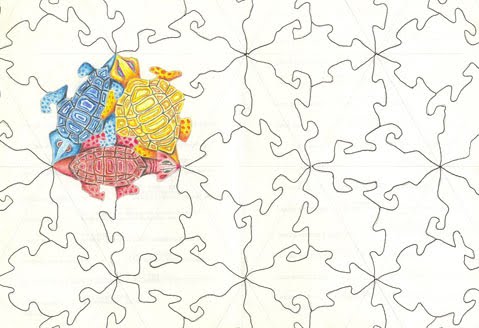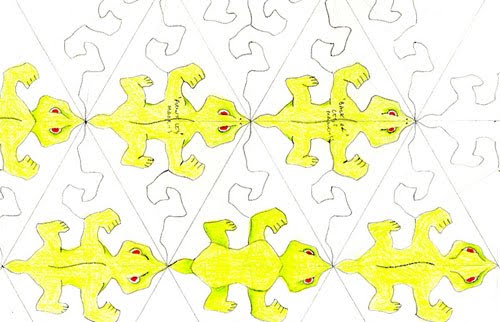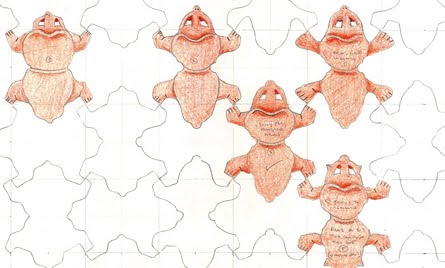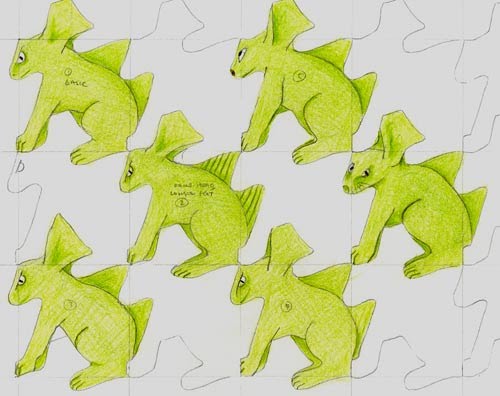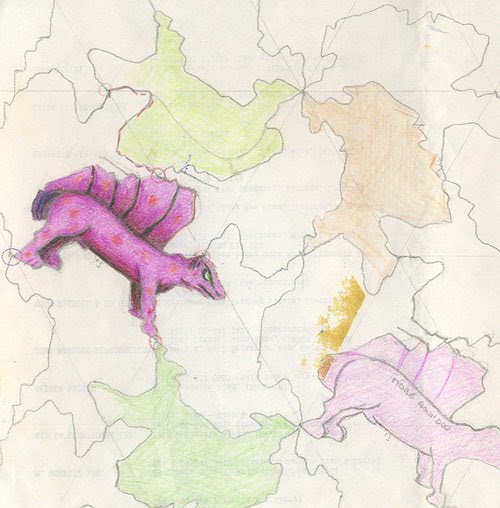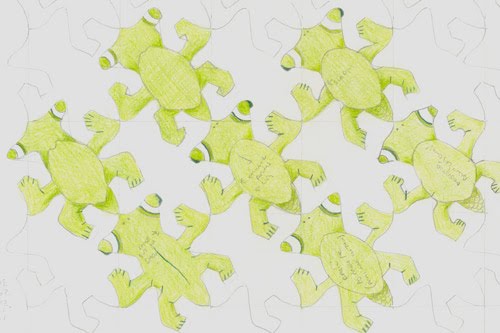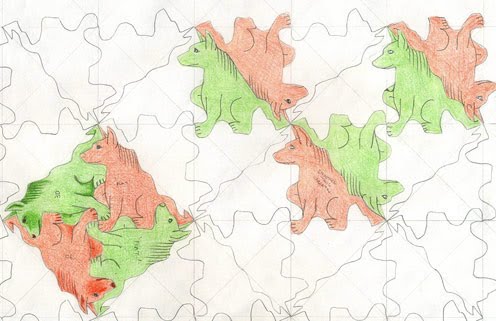A relatively easy category of motifs to compose (as there is considerable 'ambiguity of outline'), is that of what I term as 'imaginary creatures', defined as of animal-like motifs of a non-specific nature, this being in contrast to specific creatures such as birds, fish... Also included in this category are dinosaur-like motifs, of which the boundary between the two can be, but not necessarily, blurred. Rather than having an artificial distinction between the creatures, examples of these types are thus grouped together for the sake of general order. Further, more specific details of 'imaginary creatures' are discussed more fully in Essay ** No.1 These imaginary
creatures are all of a similar appearance, purposefully so, all possessing a
shell, and furthermore all of the same basic view. Of their type, these are of
a pleasing standard, with all three motifs of a plausible nature. In contrast to most of my tessellations per se, these are shown highly detailed, with individual elements of the shell along with texture on the motifs skin. Such detail illustrates a design problem (as discussed in Essay **), that refers to the practicality of such detail - as may be readily imagined, such matters of detail would entail a time consuming rendition of the format (and number) as shown. Such practicalities would have to be taken into consideration if so hand drawn. Of course, if a computer was used, this is then not a factor per se, as any number of motifs can be replicated with ease. 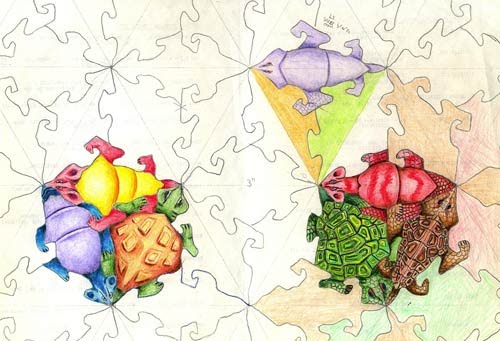 No.2 Essentially this shows further variations of the motifs of No.1, using the same outline. Such a variety of motifs (albeit of basically the same theme) simply shows how relatively easy examples of this type are to compose. No.3 A lizard of a 'reasonable' standard, due to the legs and arms of the creature being disproportionate in length, with the front ones essentially being slightly too large in comparison with the back ones. Ideally, these would be proportionate. No.5 A typical example of the border between
an imaginary creature and a dinosaur, with aspects of both. As such, pleasing
examples of its type, as all the elements are in a broad proportion. Minor
variations of the basic model are tried, such as with the face, ears and legs. No.6 A typical
example of a creature that has both imaginary creature and dinosaur likeness.
If its limitations are accepted, it is of a pleasing standard, its elements
being broadly in proportion. A noticeable feature of this it that it illustrates a principle of design concerning the 'duality of line', this aspect being discussed in greater detail in Essay **. Essentially, this is based upon a parallelogram, the longer in length side consisting of a line that is translated that represents both the back and belly. From this, it can be seen that the back of the motif, consisting mostly of a 'protective plate' is less critical in its resemblance than the belly region, as the former is less crucial in its portrayal, with considerable ambiguity, and so consequently the belly region can thus have a more life-like appearance. No.7 A typical example of the dinosaur type,
the protective plate being a noticeable (and recurring) feature. If its
limitations are accepted, it is of a pleasing standard, its elements being
broadly in proportion. No.10 A typical example of an imaginary creature, described simply as of a 'bug-like' nature. As such, it makes no pretence at bearing a resemblance to an existing one in the real world beyond merely appearing to be 'correct' in an proportional sense. Minor variations of the basic model are shown, these being an attempt at defining the 'best'. However, as such this aspect is essentially inconsequential, as they are all of a muchness. Examples of this type, of an ambiguous creature, itself having considerable 'ambiguity of outline' are easy to compose and so pose no real challenge. No.11 A typical example of an 'imaginary creature', as it defies a simple description - an alien perhaps? The outline possesses considerable ambiguity, as it shows two motifs that are indeed truly distinct and not merely minor variations of each other. Although the outline is mirror symmetrical, the vaguely 'alien' motif is shown with its head turned, which thus negates the symmetry aspect in a local sense. Arguably, such an 'interpretation' for the outline is not ideal, as the motif is inherently unsuitable. In contrast, the lizard-like motif is 'better', as this is shown with its internal symmetry in accordance with the outline. No.12 A typical example of an imaginary creature, with essentially a dog’s head on a dinosaur-like body. Of its type, this is quite pleasing, as the elements are in relative proportion. Indeed, the dogs head is of a superb quality, as it is indistinguishable from a real-life dog. By way of experimentation, both flat and three-dimensional examples are tried, of which the latter is a noticeable improvement over the former. Such attention to detail at this study stage thus shows the benefits when the finished work is executed. Last Updated: 30 September 2009 |
